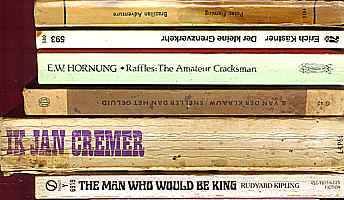

comparing the viewpoints on history of different countries
they can get pretty old...
(we stay away here from Arabs-Israelis, slaves-bosses and all that heavy stuff)
ship building
The burning question does not seem to be "who's right?" but rather "who else is right?"
motion pictures
the Armada
Discovery of America

Santa Maria
Steam across the Atlantic
That's my candidate, but at least I took the trouble to check it all out.
printing
Not to mention Koreans: they claim movable metal type was used there forty years before Gutenberg. (If it's North Korea claiming that, I put precious little trust in it. Come to think of it, the same goes for South.)

The Monster Artist
merehouse painter who grew too big for his ladder. But that's Allied propaganda. In fact, he dabbled in water colors, and not at all as bad as they make out, either. Agreed, this is not a masterpiece.
They also remark there are no humans in his paintings. True for this one (where it's raining, give those extras a break) but judging from others I've seen, not really. So what, anyway? Then, they used to say the same about my work — only, my most-published stuff contains nothing but people. Hitler was bad enough as he was and doesn't need improving.
For long, I've thought that a clue to who really was the inventor might be hidden in the way titles are printed on books' spines. When you stack up books with the covers up, the English and German books' titles used to be printed upside down. The English started changing this around 1950; the Germans are still at it. But Dutch books have their title right sight up! Where do those different traditions stem from?
When you hold a book in your hands, the German way is most logical: You can read front and spine. When you stack 'em, the Dutch way is handiest. On a shelf, there's not much more in it one way or the other.
When I started looking for examples, I immediately found an exception for Holland, of course.
So it's not much of a clue; at least that's settled.
copyright notice
SEARCH this site or the Web

all material on this site, except where noted
copyright © by , curaçao
reproduction in any form for any purpose is prohibited
without prior consent in writing







